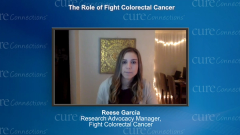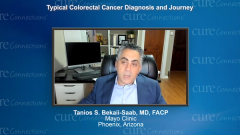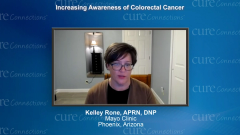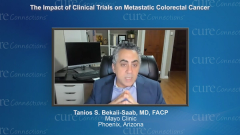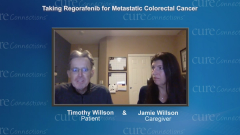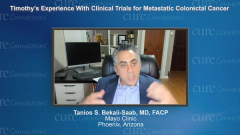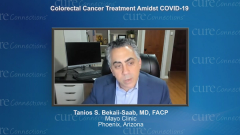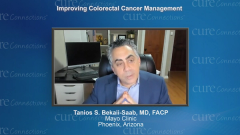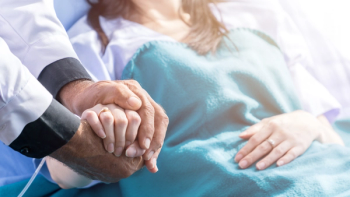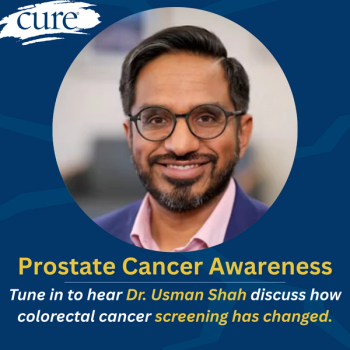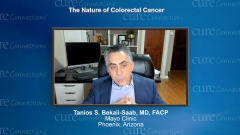
Colorectal Cancer Treatment Amidst COVID-19
Episodes in this series

Tanios S. Bekaii-Saab, MD, FACP: We are still living in the world of COVID-19 [coronavirus disease 2019]. Hopefully it will soon be behind us, but it is not too soon, sadly enough. We are seeing the light at the end of the tunnel.
Tim, especially as we started to understand how this can be even more complicating for the lives of our patients with cancer and even worse for those on treatment, how has this pandemic impacted your treatment process? You have been through a lot for the last nine years from diagnosis, early stage disease, then later stage disease, to then going through a lot of trials, and you are navigating through your cancer and have to think about COVID-19. Tell us more about how this affected you. How did this affect your line of thinking about coming to the clinic and about getting treatment?
Timothy Willson: On the one hand, I am going, “What else is going to go wrong here?” Then it turned into a full-fledged pandemic. You are exactly right because I am now a high-risk patient. Going outside the house in the beginning is scary because, as I said, if you are in that group, then you should be staying home and not doing anything, which was hard on me. Everything else was closing in, and I have never seen the whole country in such a panic like this. You then put on top of it what I am dealing with, and it seemed like a double whammy type thing. I was confident that every precaution was being taken.
I had a procedure this morning, and it was 72 hours before to get tested, so there are a lot of things and a lot of hoops you have to jump through. At the end of the day, I felt confident in going to the clinic and that nothing bad was going to happen there, aside from going to a restaurant or something like that. I have a lot of confidence in my health care provider team and the direction they said I should be going in to put me on a path with the best direction.
Tanios S. Bekaii-Saab, MD, FACP: Jamie, you are again dealing with a treatment and with the thought of cancer. On top of all this, your mind has to go through, “Oh, God, now there is this COVID-19.” We are not thinking about ourselves; we are thinking about our loved ones and “What if I get exposed to it and bring it home? What if my child gets exposed to it and brings it home?” How did COVID-19 affect your thinking and your feeling about Tim getting treatment or even venturing out of the house, even in full gear?
Jamie Willson: I tried to discourage him from leaving the house at all.
Timothy Willson: That is just great.
Jamie Willson: This puts a lot more on me: I run all his errands, but I just think it is the most prudent thing to do. With our son, it has been a bit of a discussion in terms of how much we keep him home or let him have a bit of a life. We have let him out a bit, but obviously in the safest way possible.
To answer your question about treatment, the definite benefit of treatment outweighs any risk. To Tim’s point, we felt confident that the Mayo Clinic has taken every precaution possible to keep people safe. We have felt safe about him being there. We had to go to the ER [emergency department] once, and I was not excited about it, but Mayo has done everything in their power—and again, the benefits certainly outweigh the potential risk.
Tanios S. Bekaii-Saab, MD, FACP: Yeah. Mayo and a lot of other places as well have done a great job of protecting patients, especially the most vulnerable, whether that means cutting down on the risk of exposure or keeping things quite clean. It is not that we discovered soap during COVID-19. We had soap before COVID-19, but we certainly took way more elements like limiting visits, which was sometimes painful for not just the patient but also the provider. We always love and enjoy having family members with the patient, but we had to limit exposure, and that was mostly for the safety of our patients.
You are right: In the first stages of the pandemic, I started wearing scrubs because we did not understand a lot about the virus and its transmission. Starting in August, I shut off the scrubs and started wearing my suits, and I am thinking that this is the safest and cleanest place I could be. I am the least worried around the clinic and clinic space, so I got to be comfortable. If I am comfortable to have you in the clinic, I should be comfortable wearing my suit and being able to be there. We still, of course, do all the proper measures—wearing masks, distancing, using glass, cleaning up, and all this—but that certainly adds value.
Reese, I want to get back to you because I am sure, especially during this pandemic, that you have been bombarded about how you get information. “I am anxious about COVID-19. Should I continue with treatment? Should I change my treatment? Are clinical trials more risky?” How have you and your organization handled the situation, which is not ending tomorrow? It will be ending but not tomorrow. How have you been handling this time?
Reese Garcia: We wish it would end tomorrow, that is for sure. Initially, when COVID-19 came to light in the United States, we started hosting focus groups and putting out surveys to our community. It was no surprise: Our community shared some of the sentiments that Tim was just sharing. One of the things we found is that we can get creative with our communications, and it has strengthened our ability to have that bidirectional conversation with community members. No longer are we putting all our time and effort toward in-person events, even though once COVID-19 is gone, we would like to bring that back and have a hybrid model. We have been able to get creative with how we are delivering webinars and having panels vs. just didactic communication and so forth. We have been able to up our email communications, and we have seen a bit more engagement in that sense. Having the community telling us what they are needing, what they are facing, and the issues that they are seeing that are lived and true is giving us the ability to respond in real time.
Tanios S. Bekaii-Saab, MD, FACP: It has certainly been an interesting time for all of us, and it has been a learning experience. We are going through it, and thankfully our patients have been quite protected. I am happy to say that, for almost all our patients, if not all of them, we have been able to help them navigate through the pandemic. Have we established certain patterns of changes? Of course. Have we limited certain aspects of how we do it? Yes. Have we increased our utilization of telemedicine? Yes, to a certain degree. We certainly think that telemedicine will become part of the future of how we care for patients, but it will not replace face-to-face interactions. Most of our patients need to be seen face-to-face when they get treated on-site.
We have instituted logical applications of telemedicine. Of course, for now we leave quite a bit as a discussion point between the patients and us, but I will think about that in the future. For example, Tim, I am thinking about regorafenib. At the time you were on the trial, you were coming in every week at least for the first month to see Kelley. After that, we started spacing it out. In the future, I may need to physically see you only once every couple of months, and maybe in the middle we will do a telemedicine visit. In the long run, we will limit it quite a bit and try to minimize the physical communication when it makes sense. We have a lot of patients who travel distances, and for someone who just needs to discuss their scan or their labs every six months, we certainly do not need them to travel. For most of our patients, I do not see telemedicine replacing physical care: It is just a good supplement and complement to what we do.
During COVID-19, which continues on, we started thinking more and more. As capacity gets limited, especially during those surges like in Arizona—we are having a big surge that will hopefully tone down—patients are more reluctant to travel. It sometimes makes it a bit challenging, and we also have to think about the immunosuppressive potential of our agents and the added risk to patients. For example, Tim, you mentioned regorafenib. You are not on it now, but back then you were. When we think about the process for our patients, when I have the option between regorafenib and TAS-102 [trifluridine, tipiracil hydrochloride], I try to pick regorafenib for many reasons. One is that it is less immunosuppressive than TAS-102 [trifluridine, tipiracil hydrochloride], which can essentially lead to drops in blood counts and increase the risk of immunosuppression.
When I am thinking about an oral formulation vs. an IV [intravenous] formulation, depending on the setting, I am not going to take an oral drug and replace FOLFIRI [5-fluorouracil, leucovorin calcium, irinotecan] or FOLFOX [5-fluorouracil, leucovorin calcium, oxaliplatin], which are needed in the first- and second-line settings, but I certainly think about how quickly I want to tone it down to capecitabine maintenance, for instance. I am thinking about de-intensification strategies, which makes sense overall, COVID-19 or not. COVID-19 has certainly accelerated us moving into this world.
Transcript Edited for Clarity

